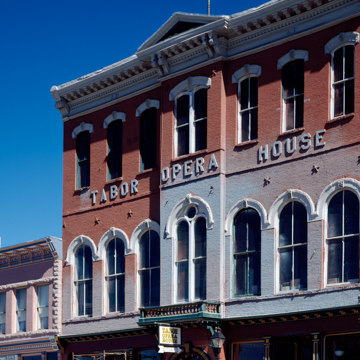One memorable night in 1882, Oscar Wilde stepped onto the stage of the Tabor Opera House wearing a dark velvet suit, knee britches, and a Lord Byron collar. His full, sensuous lips parted in a smile, and he began to lecture the miners of Leadville on “The Practical Application of Aesthetic Theory to Exterior and Interior House Decoration, with Observations on Dress and Personal Ornament.”
Like Wilde's lecture, this Italianate opera house, allegedly constructed in a hundred days, epitomizes the mining frontier's rush to respectability. The three-story brick building incorporates a central pedimented pavilion with a round-arched, fanlighted entry beneath a balcony. The entry is flanked by storefronts with their own recessed central entries. Flattened-arch sandstone window tops adorn the third floor, while round arches with carved keystones grace second-floor windows. The little-altered interior contains a wobbly wooden balcony with some 700 Andrews patent cast iron, plush-upholstered opera chairs, which were lugged over Weston Pass in wagons. Briefly known as the Weston Opera House, then as the Elks Opera House, the building was acquired in 1955 by local resident and author Evelyn Furman, who opened it for tours and performances.

